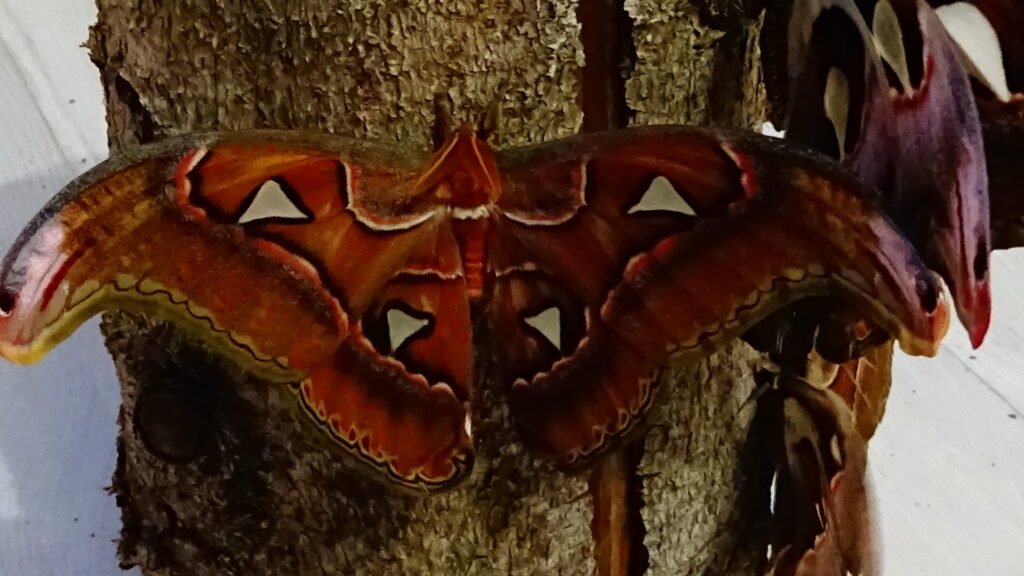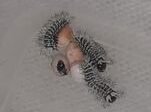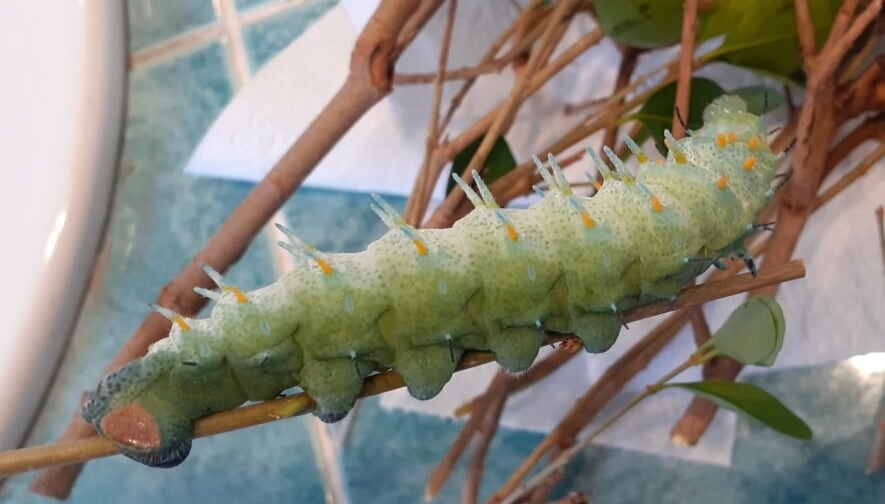C.& R. Felder 1861
Occurrence: Philippines, Luzon Island
Biotope: Tropical biotope
Food plants: Ailanthus altissima, Ligustrum, Syringa, Citrus, Salix, Persea, Coffea, Aerrhoa, Morus, Ficus, Machylus, Fraxinus, Prunus
Voltinism: Multivoltine
Pupation: caterpillars spin a cocoon with their silk.
Difficulty: This species can be challenging, they need the conditions to be right but even then they can struggle. They can easily fall victim to disease.

Attacus lorquinii is a moth of a gigantic size from the genus Attacus, and is endemic to the Philippines, meaning it is found only in this region. Given its appearance, it closely resembles the well-known moth from this genus - Attacus atlas. not only in appearance but also in rearing
The wingspan can reach up to 28 cm, with the fact that females are usually larger.
The tips of the front wings mimic the head of a snake, thereby deterring predators. This form of mimicry is called "Batesian" (after H. W. Bates), a form of mimicry where a harmless creature, in this case A. lorquinii, mimics a dangerous or venomous species (a snake).
Sexual dimorphism is not pronounced but is present. Males are generally smaller and have large feathered antennae, typical of males from the family Saturniidae. The windows (occeli) on the male's wings are triangular in shape and smaller than those of the female. The female's windows differ mainly in their pear-like shape. Another significant difference is the female's abdomen, which is huge compared to the males and full of eggs.
When breeding, good hygiene is important and there should not be too many caterpillars together. Approximately 10-12 individuals.
The eggs are white-pink in color and gradually darken during the caterpillar's development. The caterpillars hatch from the eggs in about a week, but as with other species, this depends on the temperature. It's good to keep the eggs in a moist environment but not to spray them directly to prevent mold.
L1 - Freshly hatched caterpillars are white-black in color and have small black heads. At this stage of life, the caterpillars can be fed and reared in a plastic box during the first days.
It is important to keep the caterpillars warm throughout the rearing period and to regularly change the food plant to ensure it remains fresh. In addition, maintaining excellent hygiene and regularly cleaning the enclosure is extremely important. From my personal experience, this species does not require additional moistening but prefers dry and warm conditions.

L2 - In this instar, the caterpillars are noticeably larger and more striking.
An orange pigment appears on the lateral side of the rear part of the caterpillars.
The entire body surface of the caterpillar is covered with a waxy coating.
This coating is commonly found in the genus Attacus, most likely serving to protect the caterpillars from rain or other disturbances.
During this period of life, it is necessary to enlarge the enclosures where the caterpillars are being reared. From my experience, it is best to replace the top of the box with a monofilament mesh to allow for airflow.

L3 - During this phase, the caterpillars grow at a rapid pace, are significantly larger, and the waxy coating is very visible.
The protrusions on the caterpillar's body (tubercles) increase in size, and the spiracles (breathing holes on the caterpillar's body) on the sides of the caterpillar are visible.
In this stage, it is advisable to move the caterpillars to a smaller mesh enclosure, but they can be moved up to the 4th instar. Personally, I prefer to change the enclosure already in L3 for better air circulation and a larger amount of food.

L4 - Color changes are clearly visible; the tubercles on the front part of the caterpillar near the head area turn an orange shade. The caterpillar begins to have a blue-green hue across the entire body surface.
In this instar, caterpillars should be placed in a large, spacious enclosure, adhering to the principles of maintaining hygiene, fresh food, and a dry, warm environment.

L5 - During this period, the caterpillars begin to consume huge amounts of food. They are large and green with hints of blue.
The tubercules on the bodies of the caterpillars are more spiny and visible.
The waxy appearance is less noticeable than in previous stages, but a coating or dusting is still present on the bodies of the caterpillars. The tubercles are orange at the bases and bluish at the tips. The spiracles also have a bluish tint.

L6 - In this instar, the food should be changed 1-2 times a day, typically in the morning and evening.
The caterpillars consume a huge amount of food, much more than in the previous instar. The appearance of the caterpillars does not change much from L5, but their size is incomparable.
During this period of life, which is also the last, they spend a lot of time feeding. As soon as they reach their maximum size, which under the right and favorable conditions is truly gigantic, they prepare for the next phase of their lifecycle.
The caterpillars stop eating and empty their contents in the form of liquid feces, then begin to wander around the enclosure, looking for a suitable and safe place to start spinning their cocoon.

These cocoons should be incubated in a moist and warm environment. The moths will hatch in about a month. This species does not overwinter.
Mating is recommended in a moist, warm, and well-ventilated environment. Moths are willing to mate under the right conditions, but occasionally individuals may refuse to mate and show no interest in a partner. In such cases, it is possible to try to manually pair the individuals.

